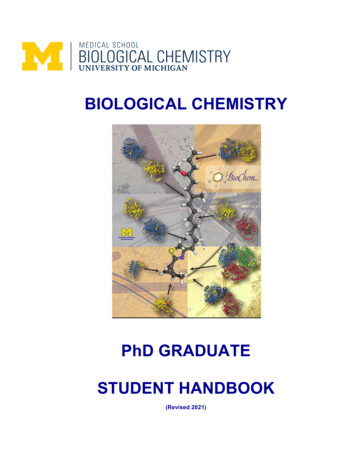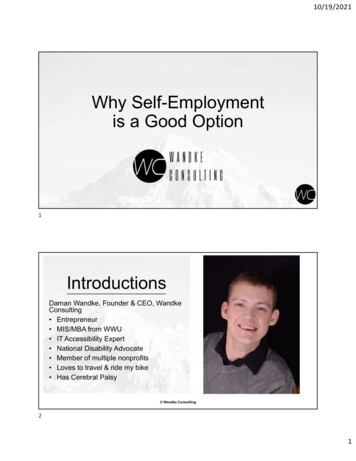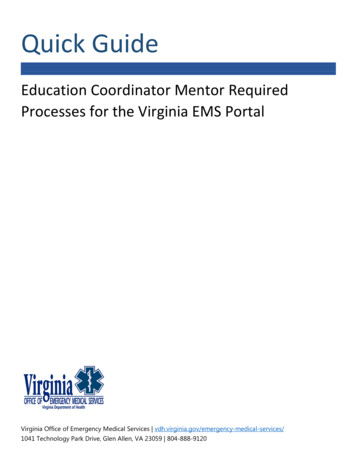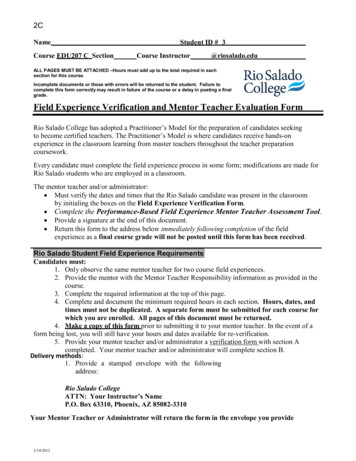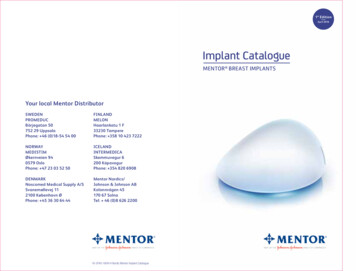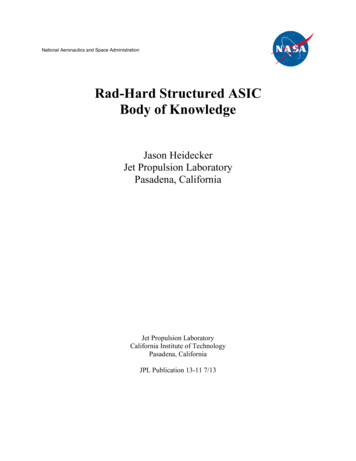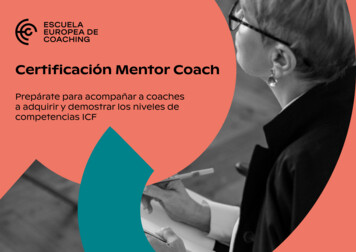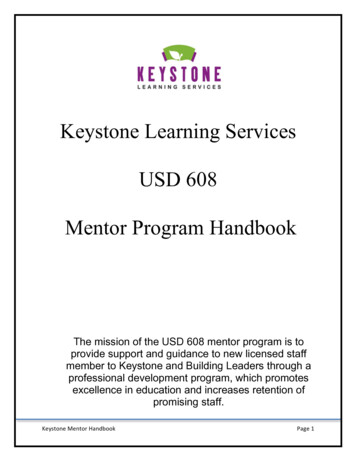
Transcription
Keystone Learning ServicesUSD 608Mentor Program HandbookThe mission of the USD 608 mentor program is toprovide support and guidance to new licensed staffmember to Keystone and Building Leaders through aprofessional development program, which promotesexcellence in education and increases retention ofpromising staff.KeystoneMentorHandbookPage1
Keystone Learning Services Mentor ProgramProgram Purpose, Goals, and StandardsPurpose:The USD 608 mentorship program is to promote excellence in educationand to increase the retention of new certified staff and building leadersthrough a professional development program. This program providesguidance, direction and support for new certified staff (including those newto Keystone, but those who have worked previously as a licensed staffmember in another special/general education setting). Success will beachieved through collaboration, modeling, coaching, encouragement, andparticipation in a continuous, professional learning community.Goals:The goals of the USD 608 mentorship program will: Support and provide one-on-one assistance to new certified staffto the Keystone Improve student achievement by promoting the personal andprofessional well-being of certified staff Increase the retention of promising certified staff and buildingleaders Provide new and beginning certified staff with immediate,personal peer contact in order to build a supportive environmentfor discovery of the Keystone culture, policies, practices, andprocedures; along with the districts that the staff will serve Establish and maintain personal and professional relationshipsKeystoneMentorHandbookPage2
Standards:Program designed according to the Kansas Model Mentor and InductionProgram Guidelines for New Teachers and School Specialists developedin 2015.The expectations and responsibilities addressed in this handbook arebased upon the Interstate Teaching Assessment and Support ConsortiumModel Core Teaching Standards (InTASC).This mentorship program will address topics and skills in these categories: The Learner and Learningo Plans instruction based on learning and developmentallevels of all studentso Recognizes and fosters individual differences to establish apositive classroom cultureo Establishes a classroom environment conducive to learning Content Knowledgeo Demonstrates a thorough knowledge of the contento Provides a variety of innovative applications of knowledge Instructional Practiceo Uses methods and techniques that are effective in meetingstudent needso Uses varied assessments to measure learning progresso Delivers comprehensive instruction for students Professional Responsibilityo Engages in reflection and continuous growtho Participates in collaboration and leadership opportunitiesProgram OrganizationAll certified staff new to the Keystone will participate in a one-day inductionprogram prior to the first contact day of returning staff. Participants in thesecond year program will meet before the school year begins.New certified staff will participate in at least one complete school year ofmentoring. Keystone offers a second year if staff request or there is aneed identified by Keystone or building administrator.KeystoneMentorHandbookPage3
Certified staff employed with 1 or more years of experience at Keystonemay be assigned a mentor at the discretion of the spedadministrator/building administrator.Please note: Additional terms of mentoring support may be requested orrequired based on licensing changes, endorsements, or at the discretion ofthe Keystone Administrator.Structured Contact Time(New Certified Staff toKeystone)1. One-day induction program prior to the first contract day of returningstaff.2. One additional meeting each semester with mentor and Keystoneadministrator (possibly outside of the school day).3. Scheduled weekly contact and assistance from mentor.4. At least 3 classroom observations throughout the school year fromthe mentor.5. Release time from classroom for observations of the mentor and/orother certified staff.Participant ResponsibilitiesMentor Responsibilities: Model professional growth and support mentee’s professionaldevelopment (InTASC Standard 9)Foster an individualized program to assess and meet the needs of thenew teacher or school specialist (InTASC Standard 2, 7)Help new certified staff to Keystone during teacher workdays, if they sodesire (InTASC Standard 10)Plan and conference with new certified staff to Keystone weeklyproviding instructional support (InTASC Standard 10)Document all contact with mentee using district communication logSupport and assist mentee with various activities related to teaching:o Planning, preparing for and carrying out IEPs including: writing,meetings and filling out additional formso Parent-teacher conferences and IEP meetings (InTASCStandard 10)o Familiarize mentee with school community and district culture(InTASC Standard 10)o IEP and progress reportsKeystoneMentorHandbookPage4
o Participating in district and state assessments (InTASCStandard 6)o Aligning instruction to state standards (InTASC Standard 7)o Other professional responsibilities, as neededObserve mentee’s classroom at least three times each year duringinstruction to offer instructional assistance and feedback (2 visitsduring the first semester) (InTASC Standards 1-8)Facilitate classroom observations by mentee of another classroom atleast one-half day per semester (InTASC Standard 10)Open your classroom to mentee and allow them to observe duringinstruction at least twice per semester (or another teacher, asnecessary) (InTASC Standard 10)Meet each semester with building and Keystone administrator andmentee (InTASC Standard 9)Keep up-to-date mentor/mentee communication logsProvide mentee with your confidence: Conversations between mentorand mentee should develop under a shelter of trust. Remember, youwill be the one they turn to when they need assistance. (InTASCStandard 9)*In the event that the mentor is unable to meet most of the needs of the mentee,the mentor should visit with the Keystone administration about possiblereassignment.**At no time should the mentor be in a role of evaluating the new certified staff.Mentors will observe and offer suggestions to the mentee, but will not be involvedin formative and summative evaluations.Mentee Responsibilities: Attend district orientation and initial meeting (InTASC Standard 10)Conference with mentor once weekly (conferences are not optionaland are a requirement of the district) (InTASC Standard 10)Meet each semester with your mentor and Keystone administrator(InTASC Standard 9)Attend required Keystone,district and building training sessions(InTASC Standard 10)Complete mentor program evaluation and provide feedbackRequired minimum of three classroom visits throughout the year bymentor while mentee is teaching (2 visits during the first semester)(InTASC Standards 1-8)Required minimum of one-half day of observation each semester bymentee during mentor teacher’s or specialist’s instruction (InTASCStandards 1-8)KeystoneMentorHandbookPage5
*Ask questions, offer lesson plans for review, and strive to becomefamiliar with your building and staff (InTASC Standards 7, 9, 10)School specialist mentor must be in the mentee’s area of specialty.This means mentor may be from another school.Keystone Administration Responsibilities: Recruit, select, match, and reassign (as needed) mentor certified staffand school specialists with new teachers and school specialists withintKeystone and the district that the mentee serves (for itinerants thismay be someone outside the district,s the mentee serves as necessary(ISLLC Standards 2-4)Support the mentorship program (ISLLC Standards 2-4)Assist in scheduling and coverage of classes to allow formentor/mentee observations (ISLLC Standards 2-4)Provide program feedback to participants and to the mentor programcoordinator (ISLLC Standards 4)Meet with the mentor/mentee once each semester to discuss progress(ISLLC Standards 2-4)Monitor and assess program effectiveness from various perspectives:o Participant feedbacko Trainingo Materialso Supporto Guidelines (ISLLC Standards 2-4)Aid in problem solving for concerns with mentor and/or mentee (ISLLCStandard 5)Honor confidentiality between mentor and mentee (ISLLC Standard 5)Selection and Matching ProcessTo be considered for mentoring, individual must do ONE of thefollowing: Begin training by October 1 Have previously been trained Have a master’s degree in building-level leadership from anaccredited program Be actively pursuing a master’s degree in building-levelleadership from an accredited program Be in the school specialist’s area of specialtyKeystoneMentorHandbookPage6
Selection Criteria for Mentor Teacher: Keystone Administration recommendation At least three consecutive years employment at KeystoneLearning Services Hold a professional license Highly competent in instruction and classroom management Desires to be a mentor Sufficient time availability for the new certified staff, especially atthe beginning of the yearTrainingInitial and Ongoing Training Requirements for Mentors: Address mentor’s role Develop strategies for building relationships with new certifiedstaff and school specialists Develop skills foro observation of new teachers/specialistso assessment of needs of new teachers/specialistso strategies to address the needs of new teachers/specialists Teach coaching language and practice Develop strategies for guiding new certified staff and specialiststo reflect upon their own skills Teach skills for guiding new certified staff and specialists in usingvarious types of formative assessment tools for instruction anddifferentiation using curriculum and materials approved forspecial education Guide mentee in collecting and analyzing various types of studentdata to show evidence of learning Guide new certified staff and specialists in their use of contentstandards for planning instruction Teach skills in using the professional education standards as ameasure of assessing teacher practiceNew Certified Staff to Keystone/School Specialist Training:Areas to be covered in new staff induction include but are not limited toKeystoneMentorHandbookPage7
Keystone policies – including a copy of the USD 608 EmployeeHandbook School safety Access to buildings Staff communication Licensure/staff development process/evaluations – KEEP, District Technology Content and grade specific instructional models and assessments Staff absences Student handbookAdditional areas to be addressed through mentorship program: Content and grade specific instructional strategies andassessments Differentiated Instruction MTSS – Multi-Tiered System of Supports Resources (copier, paper, media) Special education curriculum available to certified staff Professional responsibilities and expectations of staff Supervision duties Infinitec Schedules Characteristics of the community and studentsIncentivesMentors Stipend for full-time sped teacher serving as mentor: 25.00 anhour documented on data sheets. Payment will be up to 500.00accumulated for both the mentee and mentor Professional development pointsNew Certified Staff to Keystone/School Specialists Professional growth and performance Support system Professional development pointsKeystoneMentorHandbookPage8
Fulfills licensure requirements to move from provisional license toprofessional license Stipend for mentee of 25.00 and hour documented on datasheets. Payment will be up to 500.00 Professional development pointsProgram EvaluationData considered in program evaluation: Mentorship program survey: Keystone Administration Mentorship program survey: Mentor Mentorship program survey: Mentee Mentored teacher/school specialist retention rate Student Growth Measures as indicated by various assessmentssuch as the: Progress on the IEP, Dibels, Aimsweb,Surveys and data will be evaluated by the Keystone Administrators and ifappropriate building level leader to determine successfulness and/or necessarychanges to the programKeystoneMentorHandbookPage9
Keystone Learning ServicesNew Teacher/School Specialist Needs Assessment1. Describe your previous classroom or education experiences (when, where,how long, etc.) Be sure to include your student teaching/internship/practicum andother intern experiences.2. What life experiences, hobbies, or personal interests do you bring to theclassroom?3. Describe an instance where you have experienced success in theclassroom/or as an educator.4. Describe an instance when things didn’t go as planned in the classroom/of asan educator.5. What do you feel are your education strengths?6. What part of this new job are you the most excited about?KeystoneMentorHandbookPage10
Keystone Learning ServicesLetter of UnderstandingThe mentor and mentee agree 1. Time commitmentWe will meet regularly each weekTime/Duration:Day:2. Professional DevelopmentWe will observe each other teaching and conference afterwards.We will participate in required building and district training sessionsand support each other’s professional growth.3. Confidentiality PledgeWe agree that information about our personal or private lives sharedin the course of our mentoring partnership shall not be disclosed toany other person, unless required by federal, state, or local laws andregulations. Examples of the types of information that must bedisclosed are reports of abuse, threats of suicide, or admission ofactions that could be prosecuted as felonies.We further agree that the only documents and/or written recordsresulting from this mentoring process to be kept in the program’sarchives: Mentor program conference/observation logs Anonymous program evaluations4. Additional pledges:I will be a good listener.I will accept constructive feedback.I will be reflectiveI will be flexible and open.I will commit to this mentoring relationship.Mentor SignatureDateMentee SignatureDateKeystoneMentorHandbookPage11
New Certified Staff to Keystone/School SpecialistEvaluation of Mentoring ProgramName: Date:Mark the statement with the number that corresponds with your feelings about the USD608 Mentoring Program.12340Strongly disagreeDisagreeAgreeStrongly agreeNot Applicable12340My mentor provided first-year support by being caring and listening.12340This is my second-year of support from my mentor and I feel it stillmeets my needs12340I had contact with my mentor at least once a week.12340My mentor oriented me to the school and the school’s policiesand procedures.12340My mentor was available when I needed his or her help.12340My mentor suggested resources (both people and materials) thathelped my in my first year of teaching.12340The mentor program helped me be a better teacher/specialist.12340My observation of other teachers/specialists was valuable.What suggestions do you have to improve the mentorship program at USD 608?What questions/concerns do you have about the mentorship program at USD 608?KeystoneMentorHandbookPage12
Mentor Certified Staff/School Specialist Evaluation ofMentoring ProgramName: Date:Mark the statement with the number that corresponds with your feelings about the USD608 Mentoring Program.12340Strongly disagreeDisagreeAgreeStrongly agreeNot Applicable12340I was adequately prepared to be a new teacher/educator mentor.12340I had contact with my mentee at least once a week.12340I observed my mentee in their role as an educator, which included afollow-up conference.12340My mentee observed me in my role as an educator, which includeda follow-up conference.12340I familiarized the new licensed staff member to the school and theschools’ policies and procedures.12340My mentee accepted suggestions and help as offered.12340I provided suggestions to find resources (people and materials) tomy mentee.What suggestions do you have to improve the mentorship program at USD 608?KeystoneMentorHandbookPage13
Keystone Learning ServicesKeystone Administration and Building Principal Evaluation ofMentoring ProgramName of Mentor:Name of Mentee:Mark the statement with the number that corresponds with your feelings about the USD608 Mentoring Program.12340Strongly disagreeDisagreeAgreeStrongly agreeNot Applicable12340The mentor was adequately prepared to be a mentor.12340The mentor had contact with the mentee at least once a week.12340The building mentor and I oriented the mentee to the schooland its policies and procedures.12340The mentor was available to the mentee when he or sheneeded help.12340The mentor suggested resources (both people and materials) thathelped with the mentee’s first year.12340The mentee put forth adequate effort to acclimate and improveprofessionally.12340The mentee was willing to seek and accept assistance.12340The Keystone support was adequate for the mentorship program.What suggestions do you have to improve the mentorship program at USD 608?Keystone Adm/Principal signatureDateKeystoneMentorHandbookPage14
Keystone Learning ServicesAnticipated Monthly Meeting Topics:Before the Start of School Discuss confidentialityWork area-desk, computer, email, etc.Room set-up – if applicablePlanning for the first day and first week of schoolDiscipline and office referralsPlan book, how to plan, sub-plans, organization, pacing, curriculum mapLearn about copier, printers, projectors, and other resources and equipmentState and district standards—ksde.orgLocations of texts, instructional materials, and other suppliesOrdering supplies – requisitions from Keystone and the District (if applicable)District technologyClassroom management techniques: including ESIBuilding tour – work area, mailbox, parking, restrooms, etc.School activities (if applicable)Keystone and District procedures – Mission statement, Code of Conduct,Employee HandbookSupport systems at Keystone and in the District(s) if applicableDistrict and Keystone calendar - priority of eventsCommunications – use of email, phone, etc.Curriculum resources – media center, MIS Clerk, Keystone IT Dept.Supervision duties and building routines and proceduresSupervising paraprofessionalsCommunity norms and expectationsWorking with the regular education staff for services, scheduling, expectationsand goalsHow to be a team player when you are sitting on the sidelinesWorking with parents- how do you handle conflictDeveloping a schedule for servicesAugust and September Appearance and professionalismClassroom management (time, discipline, schedule, classroom setup)Curriculum and curriculum mappingTesting: SRI, SMI, DIBELS, Aimsweb, Pathways to Reading, State assessmentsBuilding policies and procedures (regular education duties, schedule work times)Chain of command/protocolGrades (if applicable) progress reportsKeystoneMentorHandbookPage15
Reporting attendance, lunch, etc.Staff development procedures and timelines (using KEEP)Copies and office useRequesting Leave, professional leave, sub plans, sick daysEmergency plans and proceduresParent-teacher Conferences and IEP expectationsChecking out and refueling school vehiclesField tripsSchedule observation of mentee with conferenceHow to conduct an evaluation: initial, re-evaluationData collection for the IEPIEP writingLeading an IEP meetingHow to schedule an IEP meetingHow to report Emergency Safety InterventionWho to contact if a student has a crisisStrategies to build relationshipsOctober Classroom management (how things are going)Regular educationStudent sped folders/recordsMeetings – IEP, GEI (SIT)Parent-teacher conferences and IEP meetingsEvaluations: formative, summative, walk-throughCollaboration time – purpose and planningOverview of previous month – concerns or questions?Quarterly data for Progress ReportsHow to participate in training through Keystone, Infinitec, othersIntroduce InfinitecIn-service hours for paraprofessionalsNovember Assessments: local and state (formatives)Classroom management (office referrals)Reviewing curriculum map and application to the IEPStaff personnel and their rolesWorking with parentsWorking with paraprofessionals – optimal utilizationEncouraging or motivating low-achieving studentsAnalyze data from local assessmentsKeystoneMentorHandbookPage16
Tardy and attendance policyMeeting student needsThanksgiving breakProfessional development – My Learning Plan on KEEPConcerns or questionsSchedule observation of mentee with conferenceDecember Meeting with mentor and building-level administratorEnd of semester dutiesClassroom managementEmergency resources – Counselor, DCFPreparation for the spring semesterSubmitting semester grades if applicableQuarterly data: SRI, SMI, DIBELS, Aimsweb,Christmas program, if applicableChristmas break: Documentation for ESYJanuary OrganizationClassroom managementAnalyze data from formative state assessments, if applicableProgress reportsSupport and answer questionsStudent transition procedures for the following yearDiscussion of testing window for state assessmentsFebruary Preparing “ALL” students for state assessmentsKeeping balance with the IEPsClassroom managementReview curriculum mapParent contactTeacher contract notification (renewal/non-renewal)Graduation issuesSpring field tripsMarch Go over Kansas Assessment Program– appearance, logging on, etc.Analyze data for state and local assessmentsSupport and answer questionsKeystoneMentorHandbookPage17
Classroom managementQuarterly data:Schedule observation of mentee with conferenceApril Progress reportsDiscuss licensure with mentee – if first year, need to change provisional toprofessional licensure using Mentorship documentation. (ksde.org)Classroom managementSurviving until MayReviewing curriculum map – changes needed?May Meeting with mentor and building-level administratorEnd of year preparationClassroom managementQuarterly data:Textbook and classroom inventoryPlan – equipment and supplies for next yearSummer payroll optionsFinals scheduleField dayTeacher check-out procedures (keys, books, grades, etc.)Summer MonthsIf you will mentor a second year, stay in touch. Keep building rapport.KeystoneMentorHandbookPage18
Keystone Learning ServicesTranscript of Monthly Meetings and Topics:Before the Start of SchoolMentee Init.Mentor InitDateDiscuss confidentialityWork area-desk, computer, email, etc.Room set-up – if applicablePlanning for the first day and first week of schoolDiscipline and office referralsPlan book, how to plan, sub-plans, organization,pacing, curriculum mapLearn about copier, printers, projectors, and otherresources and equipmentState and district standards—ksde.orgLocations of texts, instructional materials, and othersuppliesOrdering supplies – requisitions from Keystone andthe District (if applicable)District technologyClassroom management techniques: including ESIBuilding tour – work area, mailbox, parking,restrooms, etc.School activities (if applicable)Keystone and District procedures – Missionstatement, Code of Conduct, Employee HandbookSupport systems at Keystone and in the District(s) ifapplicableDistrict calendar - priority of eventsCommunications – use of email, phone, etc.Curriculum resources – media center, MIS Clerk,Keystone IT Dept.Supervision duties and building routines andproceduresSupervising paraprofessionalsCommunity norms and expectationsWorking with the regular education staff for services,scheduling, expectations and goalsHow to be a team player when you are sitting on thesidelinesWorking with parents- how do you handle conflictDeveloping a schedule for servicesKeystoneMentorHandbookPage19
August and SeptemberMentee Init Mentor InitDateAppearance and professionalismClassroom management (time, discipline, schedule,classroom setup)Curriculum and curriculum mappingTesting: SRI, SMI, DIBELS, Aimsweb, Pathways toReading, State assessmentsBuilding policies and procedures (regular educationduties, schedule work times)Chain of command/protocolGrades (if applicable) progress reportsReporting attendance, lunch, etc.Staff development procedures and timelines (usingKEEP)Copies and office useRequesting Leave, professional leave, sub plans, sickdaysEmergency plans and proceduresParent-teacher Conferences and IEP expectationsChecking out and refueling school vehiclesField tripsSchedule observation of mentee with conferenceHow to conduct an evaluation: initial, re-evaluationData collection for the IEPIEP writingLeading an IEP meetingHow to schedule an IEP meetingHow to report Emergency Safety InterventionWho to contact if a student has a crisisStrategies to build relationshipsOctoberMentee Int.Mentor InitDateClassroom management (how things are going)Regular educationStudent sped folders/recordsMeetings – IEP, GEI (SIT)Parent-teacher conferences and IEP meetingsEvaluations: formative, summative, walk-throughCollaboration time – purpose and planningOverview of previous month – concerns or questions?KeystoneMentorHandbookPage20
Quarterly data for Progress ReportsHow to participate in training through Keystone, Infinitec,othersIntroduce InfinitecIn-service hours for paraprofessionalsNovemberMentee Init Mentor InitDateAssessments: local and state (formatives)Classroom management (office referrals)Reviewing curriculum map and application to the IEPStaff personnel and their rolesWorking with parentsWorking with paraprofessionals – optimal utilizationEncouraging or motivating low-achieving studentsAnalyze data from local assessmentsTardy and attendance policyMeeting student needsThanksgiving breakProfessional development – My Learning Plan on KEEPConcerns or questionsSchedule observation of mentee with conferenceDecemberMentee Init Mentor InitDateMeeting with mentor and building-level administratorEnd of semester dutiesClassroom managementEmergency resources – Counselor, DCFPreparation for the spring semesterSubmitting semester grades if applicableQuarterly data: SRI, SMI, DIBELS, Aimsweb,Christmas program, if applicableChristmas break: ESY Data CollectionKeystoneMentorHandbookPage21
JanuaryMentee Init Mentor InitDateOrganizationClassroom managementAnalyze data from formative state assessments, ifapplicableProgress reportsSupport and answer questionsStudent transition procedures for the following yearDiscussion of testing window for state assessmentsFebruaryMentee Init Mentor InitDatePreparing “ALL” students for state assessmentsKeeping balance with the IEPsClassroom managementReview curriculum mapParent contactTeacher contract notification (renewal/non-renewal)Graduation issuesSpring field tripsMarchMentee Init Mentor InitDateGo over Kansas Assessment Program– appearance,logging on, etc.Analyze data for state and local assessmentsSupport and answer questionsClassroom managementQuarterly data:Schedule observation of mentee with conferenceKeystoneMentorHandbookPage22
AprilMentee Init Mentor InitDateProgress reportsDiscuss licensure with mentee – if first year, need tochange provisional to professional licensure usingMentorship documentation. (ksde.org)Classroom managementSurviving until MayReviewing curriculum map – changes needed?MayMentee Init Mentor InitDateMeeting with mentor and building-level administratorEnd of year preparationClassroom managementQuarterly data:Textbook and classroom inventoryPlan – equipment and supplies for next yearSummer payroll optionsFinals scheduleField dayTeacher check-out procedures (keys, books, grades,etc.)Summer MonthsIf you will mentor a second year, stay in touch. Keep building rapport.Comments or other areas addressedMentee and Mentor please complete a transcript monthly. Initial your first andlast name by the topics covered each month. Date the actual month you reviewedthe information ex. Field day was discussed 2/22/16 rather than May. Please put2/22/16 by Field day in May.Sign below, and month turn in a calendar with the times and 23
Keystone Learning ServicesMonthly Meetings for edNameDateKeystoneMentorHandbookPage24
Kansas Model Mentor and Induction Program Guidelinesfor New Teachers and School SpecialistsEach local education agency (LEA) shall have an approved program providing systemicmentoring and induction support to all new teachers and school specialists. The program mustinclude, but is not limited to, the following:1. Program provides practical application of practices that outline a newteacher’s/specialist’s professional learning needs related to: the learner and learning;content knowledge; instructional practice; professional responsibility.2. Program must include selection criteria and training for mentors:A. Selection Criteria:i. Mentor must have a minimum of three years of successful experienceand have a professional license in effectii. School specialist mentoring can be cross-district if necessary.B. Training:i. Initial training must occur by Oct. 1ii. Initial training is paired with ongoing professional learning for the mentorthat: Addresses the mentor’s role Develops strategies for building relationships with new teachers Development of skills for observation of a new teacher’s practice,assessment of needs, and strategies to address those needs Coaching language and practice Strategies for guiding new teachers to use reflection in theirpractice Skills for guiding new teachers in using various types of formativeassessment to focus instruction and differentiate for student needs Guiding new teachers in collecting and analyzing various types ofstudent data to show evidence of learning Guiding new teachers in their use of content standards whenplanning lessons/units Skills in using the professional education standards as a measureof assessing teache
leadership from an accredited program Be in the school specialist's area of specialty. KeystoneMentor(Handbook( Page7((Selection Criteria for Mentor Teacher: . New Certified Staff to Keystone/School Specialist Training: Areas to be covered in new staff induction include but are not limited to . KeystoneMentor(Handbook( Page8(

